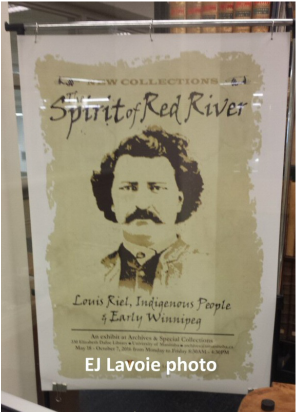
"I thank you for having goodly postponed the execution of the sentences against me. I shall make use of those days, added to my life, so as to prepare better."
These are the words of a man condemned to death, addressed to the man who condemned him to hang by the neck until dead.
All Canadians know ̶ or should know ̶ the name and the history of this condemned man. He wrote this letter to the judge while sitting in the Regina jail in the fall of 1885. On November 16th, he was taken out and hanged in the courtyard. His body rests in the churchyard of St. Boniface Cathedral in Winnipeg, in the province that he created. To most Canadians today, to the vast majority of Canadians, he is a hero and martyr.
I am writing this to discuss history, our history, Canadian history. History, my friends, is not found in books (though they can help) or in the words of historians (though many of them do help) nor in the mouths of politicians (who are almost the only Canadians who bother to reference our history because, of course, it serves their purposes). Guaranteed that you will not find it on Wikipedia.
History can be found in people who witnessed historical moments, or participated in those moments, or took steps to preserve those moments. You may talk to them if they are still able to talk (i.e., they are still alive), or you may read their words or touch the artifacts they preserved or gaze at the images they created. This is the stuff of history. This is the stuff that writers and historians and politicians interpret.
You can interpret this stuff of history yourself. You may start in a museum or archive.
I spent a week in Winnipeg recently finding stuff about, believe it or not, Greenstone history, and in the process, stumbled upon several moments in Canadian history . . .
Check out the full article and colour photos on E.J. Lavoie's blog at http://bit.ly/1QdZZ8R .
These are the words of a man condemned to death, addressed to the man who condemned him to hang by the neck until dead.
All Canadians know ̶ or should know ̶ the name and the history of this condemned man. He wrote this letter to the judge while sitting in the Regina jail in the fall of 1885. On November 16th, he was taken out and hanged in the courtyard. His body rests in the churchyard of St. Boniface Cathedral in Winnipeg, in the province that he created. To most Canadians today, to the vast majority of Canadians, he is a hero and martyr.
I am writing this to discuss history, our history, Canadian history. History, my friends, is not found in books (though they can help) or in the words of historians (though many of them do help) nor in the mouths of politicians (who are almost the only Canadians who bother to reference our history because, of course, it serves their purposes). Guaranteed that you will not find it on Wikipedia.
History can be found in people who witnessed historical moments, or participated in those moments, or took steps to preserve those moments. You may talk to them if they are still able to talk (i.e., they are still alive), or you may read their words or touch the artifacts they preserved or gaze at the images they created. This is the stuff of history. This is the stuff that writers and historians and politicians interpret.
You can interpret this stuff of history yourself. You may start in a museum or archive.
I spent a week in Winnipeg recently finding stuff about, believe it or not, Greenstone history, and in the process, stumbled upon several moments in Canadian history . . .
Check out the full article and colour photos on E.J. Lavoie's blog at http://bit.ly/1QdZZ8R .
 RSS Feed
RSS Feed
